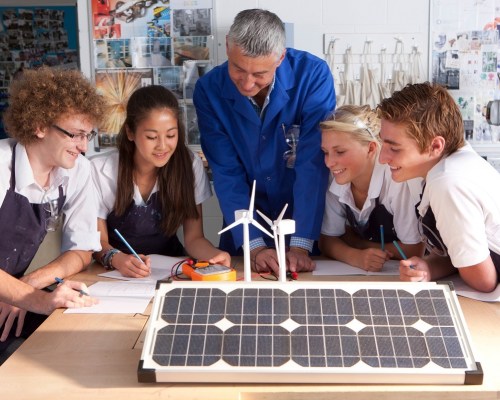Five Tips for Taking on Energy and Sustainability for Schools in 2022
It’s a new calendar year and there’s a lot going on in energy and sustainability. The federal infrastructure bill passed this fall with the inclusion of some financial benefits for schools. Though these benefits will take time to deploy, the support for a more resilient and cleaner energy grid is a win for us all. There are also provisions to help states with carbon management.
Now is the time to plan. And as you consider projects for this summer and get ready for your next sustainability steps, consider these five tips on how to get started in 2022.
1. Look for New Funding and Incentives
There is new funding out there including $500 million in the U.S. Department of Energy’s State Energy Program. This section authorizes $500 million for fiscal years 2022-2026 for the State Energy Program. It also amends the Energy Policy and Conservation Act to require state energy conservation plans to support transmission and distribution planning activities.
The act is also amended so state energy conservation plans can include programs that help reduce carbon emissions and accelerate the use of alternative transportation fuels for the electrification of state government vehicles, fleet vehicles, taxis, ride-sharing services, mass transit, school buses and ferries. It also includes privately owned passenger, medium- and heavy-duty vehicles.
Depending on where you are in the U.S., there may be other incentives as well from your utility or state available for your school. Be sure to research incentives and rebates that can further your energy and sustainability planning.
TIP: See if your school can connect to an innovative energy transformation or research project. There may be opportunities to partner with your municipality for distributed energy solutions like solar, storage and microgrid solutions. Feel free to contact us to discuss ways to connect to infrastructure initiatives.
2. Explore Energy Subscription Services
A sustainability subscription service can deliver fast wins for your carbon goals. Energy-infrastructure-as-a-service is a funding solution that allows schools and colleges to quickly implement deep energy retrofits and install renewable energy assets. It works similarly to a long-term car lease. A provider like Duke Energy Sustainable Solutions designs, builds, owns, operates and maintains the project infrastructure and solar assets. Then your school pays a predictable monthly fee. Projects can be funded as operational expenditures instead of capital ones.
The Department of Energy Better Building Solutions Center has provided a great deal of information about this trend. It’s helping schools and universities get immediate traction in achieving environmental goals. Perhaps the greatest benefit of the as-a-service model is that the performance and financial risks are usually carried by the provider, not the school. That’s a bonus for CFOs and facilities administrators as they work to get the most out of their budgets without the need for additional headcount.
TIP: Spend a little time exploring this funding mechanism. It can help your organization achieve your energy, deferred maintenance and sustainability initiatives. Consider getting an energy assessment for your campus. It can help you see where you are and create an energy action plan to guide your investments and actions. It can also help attract infusions of capital from energy-infrastructure-as-a-service vendors.
3. Invest in Renewable Energy
Rate and regulatory environments are aligning to help make solar and battery storage assets more affordable. There are also some great innovations moving into production for generating clean energy using alternative fuels and adding energy resiliency. If you aren’t in a position to construct a solar installation on your campus, don’t worry. There are Virtual Power Purchase Agreements (VPPAs), where your school can benefit from solar installations off-site.
TIP: On-site solar paired with battery storage can help offer energy arbitration (by using your saved energy to manage demand and lower your peak energy usage). You can also use your energy storage to help keep your campus up and running during outages. Consider how to maximize your solar potential and supplement with a VPPA to help achieve greater renewal energy goals.
4. Reduce Your Carbon Emissions
Your school probably has carbon emission goals. And some of your emissions are created when your electricity is generated. Different utilities have different generation mixes. Understanding the energy source mix where your school operates creates a solid baseline to build emissions reduction strategies. Much of the grid-source electricity produced in the Midwestern states comes from coal-fired power plants, while other grid-sourced electricity nationwide is fueled by more wind, hydro, solar and nuclear, which deliver a lower emissions generation mix.
TIP: See how much carbon emissions are created when your grid energy is generated with our carbon calculator. It can help you establish a baseline for your sustainability goals. And keep an eye out for opportunities to reduce your emissions. For example, replacing fossil fuel-powered steam systems with grid-powered heat pumps can greatly reduce your overall carbon footprint. Depending on your loads, converting from steam to hot water generated by heat pumps can also reduce your energy costs. Heat pumps can be used for both your heating and cooling loads and can be installed as part of an innovative district energy system. They can help make your energy use more efficient and advance your carbon initiatives.
5. Schedule a Campus Energy Consultation
Duke Energy Sustainable Solutions has consultants to help educators better understand the energy landscape and how to best tackle the tough conversations on campus. When given the opportunity, we can promote great conversations among key campus stakeholders across finance, facilities, sustainability, faculty, students and executive leadership.
TIP: Is there someone at your campus who can bring all stakeholders to the table to discuss sustainability and energy initiatives? Bring that person onboard. It’s also important to involve executive leadership and finance in these discussions early in the process. Consider bringing in a consultant who can help.
Wayne Johnson is key segment manager for Duke Energy Sustainable Solutions. Wayne is a veteran facilities administrator and works to bring education leaders together across the nation to make an impact on energy and sustainability.
Wayne consults with colleges, universities and K-12 school leaders at no cost, to help them navigate the clean energy transition. If your leadership is ready to take the next steps, reach out to schedule a free one-hour consultation.



